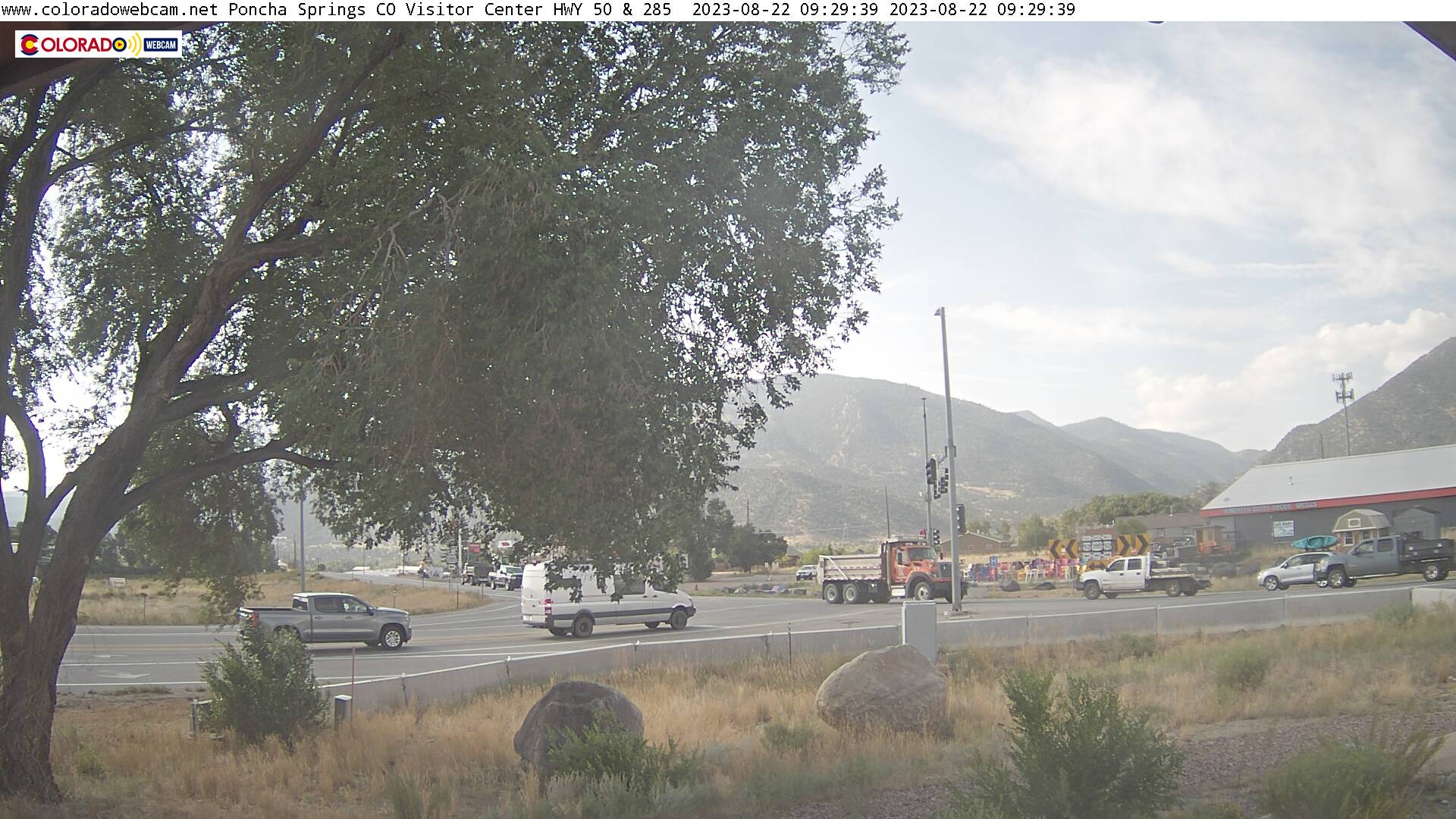Poncha Springs, Colorado Weather Cams
Poncha Springs Visitor Center (via Coloradowebcam.net)

Poncha Springs: Crossroads of the Rockies and Echoes of the Springs
Poncha Springs, Colorado Weather Cams. Tucked into the Upper Arkansas River Valley at the junction of U.S. Highways 50 and 285, Poncha Springs, Colorado, is a small town with a rich and layered past. Known today as the “Crossroads of the Rockies,” this community in southern Chaffee County has long served as a vital passageway—first for Indigenous peoples, then for explorers, settlers, and modern travelers. Its story is one of natural abundance, frontier resilience, and evolving identity.
Indigenous Roots and Early Exploration
Long before European settlers arrived, the area that would become Poncha Springs was part of the seasonal migration routes of the Ute people. They wintered in the lower valleys and summered in the high country, relying on the region’s abundant game, edible plants, and hot mineral springs. The springs, which bubbled from the earth at temperatures ranging from 90 to 185 degrees Fahrenheit, were considered sacred and healing.
Spanish explorers were among the first Europeans to traverse the region. In 1779, Juan Bautista de Anza led a military expedition over what is now Poncha Pass, just south of the present-day town. French trappers and fur traders followed in the early 1800s, drawn by the promise of beaver pelts and other resources.
Settlement and the Birth of a Town
The first permanent non-Indigenous settlers arrived around 1860. Nat Rich and Bob Hendricks built the town’s first cabin, which still stands today. James Rich, Nat’s son, became the first white child born in Poncha Springs in 1867. That same year, the area was designated an election precinct, signaling its growing civic presence.
John Burnett, an Indian agent, homesteaded nearby with his wife, Minerva Maxwell Burnett, one of the area’s first schoolteachers. Burnett also constructed a log trading post in 1866, which served as a supply hub for both settlers and Native Americans. Other early homesteaders included the Hutchinson and McPherson families, who helped lay the foundations of the town’s economy and infrastructure.
The Rise of the Springs and the Railroad Boom
Poncha Springs’ mineral waters were a major draw. While some credit Lt. Zebulon Pike with their discovery in 1806, others believe Kit Carson encountered them in 1832. Regardless, by the late 1860s, locals had begun to develop the springs for public use. Burnett, Henry Weber, and Paul Irvine dug a large pit, lined it with logs, and created the first spring-fed bath. A log fence and later a wooden shack provided privacy for bathers.
The arrival of the Denver & Rio Grande Railroad in 1881 transformed Poncha Springs into a bustling health resort and transportation hub. Two hotels were built near the springs, attracting visitors from across the country. Notable guests included Civil War veteran, Ulysses S. Grant, and even the infamous Jesse James. The Jackson Hotel, completed in 1878, became a local landmark and survived the town’s many fires.
Poncha Springs was officially incorporated on December 8, 1880, with a population of 350. The vote was overwhelmingly in favor—70 to 1. At its peak, the town boasted over 2,000 residents, 17 saloons, and the first library in Chaffee County.
Fire, Decline, and Reinvention
Tragedy struck in 1887 when a massive fire destroyed most of Poncha Springs’ wooden buildings, including its saloons and churches. Another fire in 1932 claimed the Presbyterian Church, built in 1882. Despite these setbacks, the town rebuilt and adapted.
The springs, once the town’s crown jewel, suffered a quieter fate. After two hotel fires in 1893 and 1903, the Holman family took over management in 1904. They found a hand-plastered rock pool, two cabins, and a sleeping room still in use. In 1935, the City of Salida piped the spring water to its municipal pool as part of a WPA project. The springs were capped with cement and have remained under Salida’s ownership ever since.
Civic Life and Preservation
The Poncha Springs Schoolhouse, completed in 1883, became a cornerstone of community life. It served as the town hall until 2017, when a new municipal building was constructed next door. The schoolhouse now houses a preschool and a museum, preserving the town’s educational and civic heritage.
Poncha Springs has long been known for its prohibitionist leanings. Early property deeds included clauses forbidding the sale of alcohol—a rarity among Colorado’s mining towns. The town also maintained a rare public library during the late 19th century, reflecting its residents’ commitment to education and culture.
Chaffee County and the Broader Landscape
Poncha Springs is part of Chaffee County, established in 1879 and named for Jerome Chaffee, a mining investor and one of Colorado’s first U.S. senators. The county lies along the eastern slope of the Rockies and includes the Arkansas River Valley, a region rich in natural beauty and historical significance.
The area’s economy has evolved from mining and agriculture to tourism and outdoor recreation. Nearby Salida and Buena Vista offer rafting, hiking, and cultural events, while Poncha Springs serves as a quieter gateway to the region’s many attractions.
A Modern Crossroads
Today, Poncha Springs is home to around 1,400 residents and continues to grow. It remains a vital junction for travelers heading to Monarch Pass, the San Luis Valley, or the Arkansas River corridor. Tesla even operates a supercharger station in town, a nod to its enduring role as a waypoint in Colorado’s transportation network.
Though the mineral baths are gone and the railroads no longer whistle through town, Poncha Springs retains its frontier charm and historical depth. Its story is one of adaptation and quiet perseverance—a small town that has weathered fire, change, and time, yet still stands at the crossroads of Colorado’s past and future.
For more information, visit the Poncha Springs, Colorado official website.
